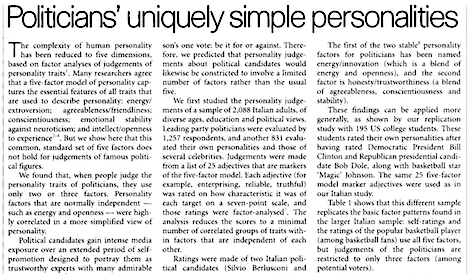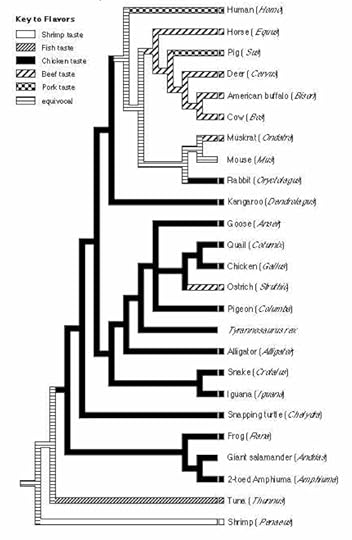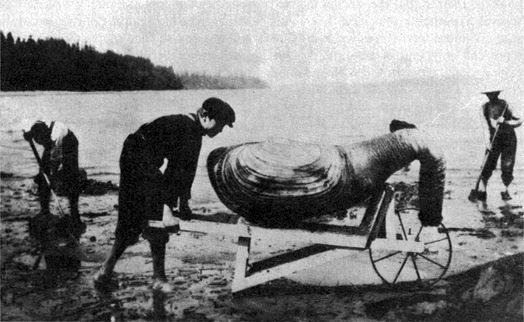Marc Abrahams's Blog, page 603
January 24, 2012
Tastes Like Chicken
Rocketboom reports on Joe Staton's study "Tastes Like Chicken, which was published in volume 4, number 4 (in 1998) of the Annals of Improbable Research:
Staton is a professor at the University of South Carolina. A chart from his study is reproduced below. You can find a pdf of the entire article here.
BONUS: The study is cited in
Toczyski, S. 2010. Jean-Baptiste Labat and the buccaneer barbeque in seventeenth-century Martinique. Gastronomica: the Journal of Food and Culture 10: 59-69.
BONUS: Staton tells us; "I think sometimes I get more press on that one paper than any of my 'real' work."

January 23, 2012
Pork, the surprise (yet traditional) remedy for a nosebleed
 A new medical study recommends a method called "nasal packing with strips of cured pork" as an effective way to treat uncontrollable nosebleeds.
A new medical study recommends a method called "nasal packing with strips of cured pork" as an effective way to treat uncontrollable nosebleeds.
Ian Humphreys, Sonal Saraiya, Walter Belenky and James Dworkin [pictured here], at Detroit Medical Centre in Michigan, treated a girl who had a rare hereditary disorder that brings prolongued bleeding. Publishing in the Annals of Otology, Rhinology and Laryngology, they pack the essential details into two sentences:
 "Cured salted pork crafted as a nasal tampon and packed within the nasal vaults successfully stopped nasal hemorrhage promptly, effectively, and without sequelae … To our knowledge, this represents the first description of nasal packing with strips of cured pork for treatment of life-threatening hemorrhage in a patient with Glanzmann thrombasthenia."…
"Cured salted pork crafted as a nasal tampon and packed within the nasal vaults successfully stopped nasal hemorrhage promptly, effectively, and without sequelae … To our knowledge, this represents the first description of nasal packing with strips of cured pork for treatment of life-threatening hemorrhage in a patient with Glanzmann thrombasthenia."…
So begins this week's Improbable Research column in The Guardian.

The great geoduck hoax photo
Peter Smith, in the Smithsonian's Food & Think blog, tells of the great geoduck hoax photo. Here's a copy of that photo:
[via Annalee Newitz]

TV interview with the promote-at-random researchers
RAI-3′s Telecamere program interviewed the three random-promotion researchers. Here is the full, glorious interview, in Italian:
The trio — Alessandro Pluchino, Andrea Rapisarda, and Cesare Garofalo of the University of Catania, Italy — were awarded the 2010 Ig Nobel Prize in management for demonstrating mathematically that organizations would become more efficient if they promoted people at random.
Their published study (which they followed up with others) is: "The Peter Principle Revisited: A Computational Study," Alessandro Pluchino, Andrea Rapisarda, and Cesare Garofalo, Physica A, vol. 389, no. 3, February 2010, pp. 467-72.
BONUS: The researchers will be part of the upcoming Ig Nobel Tour of Scandinavia, in March.

How to Begin a Scientific Report: Headless, Topless
Here's one way to begin a scientific report. Grab the reader's attention:
"Real faces, real emotions: perceiving facial expressions in naturalistic contexts of voices, bodies and scenes," Beatrice de Gelder [pictured here] and Jan Van den Stock, in A.J. Calder, G. Rhodes, J.V. Haxby & M.H. Johnson (Eds.), The handbook of face perception. Oxford: Oxford University Press. The authors, at Tilburg University, The Netherlands, Massachusetts General Hospital, Charlestown, Massachusetts, USA, and KU Leuven, Belgium, begin:
"For a while 'Headless Body in Topless Bar' counted as one of the funniest lines to have appeared in US newspapers. But headless bodies and bodiless heads figure only in crime catalogues and police reports and are not part of our daily experience, at the very least not part of the daily experience that constitutes the normal learning environment in which we acquire our face and body perception expertise. Yet, except for a few isolated studies, the literature on face recognition has not yet addressed the issue of context effects in face perception. By 'context' we mean here the whole naturalistic environment that is almost always present when we encounter a face."
BONUS: The original newspaper headline, in the New York Post:

BONUS [via Wesley Coll]: 'Headless Body in Topless Bar' killer seeks release from prison

January 22, 2012
A peculiar Scottish disorder
- is described in the Scottish Medical Journal (SMJ), August 2011 vol. 56 no. 3, pp. 164-166 (by Doctor I. B. McIntosh.)
"A highly contagious behavioural affliction is now endemic in highland areas of Scotland. Pretravel advice ought to include a health warning to sport-lovers venturing north into wild, highlands of Gaeldom. It particularly affects young adults and predominates in men, although women are affected. The disorder can be acute or chronic and when severe, it can threaten one's life and limbs. Acute attacks may bring spontaneous recovery in months, but the chronic state can last for a life-time. Death will overtake some before it runs its inevitable course."
 Symptoms range from apparently mindless wandering (mimicking early dementia) to snow-blindness. And there can be acute side effects such as bruises, sprains and even broken bones.
Symptoms range from apparently mindless wandering (mimicking early dementia) to snow-blindness. And there can be acute side effects such as bruises, sprains and even broken bones.
A cure remains elusive, but meanwhile, as a preventative measure, Dr. McIntosh recommends the implementation of a quarantine exclusion zone covering all mountainous areas north of a line from Stonehaven to Helensburgh. (See illustration above.)
Non subscribers to the SMJ can examine the disorder in detail here for US$30.00. But for our readers who are determined to stick with the free abstract, Improbable can reveal that the disorder may be related to 'Munro Bagging'- a currently active trend in hillwalking which produces a craving in those afflicted – an almost irresistible desire to climb all Scottish mountains over 3,000 feet. The so-called Munros. According to official figures from the Scottish Mountaineering Club, there are 283 Munros (and 227 further subsidiary tops). Those (sufferers) who are driven to complete the task in its entirety are known as 'Compleaters'.
(Illustration courtesy the author, Iain McIntosh)

Politicians R 2 Simple, explain 2 Ig Nobel winners
Politicians are too simple.
Two Ig Nobel Prize winners — both, as it happens, professors at Stanford University — each gives part of the explanation. (As with many simple facts, the explanation is a bit complex.)
Politicians' simple debates
 Professor John Perry, a philosopher, looked at politicians' televised debates. In an essay for the New York Times (on January 21, 2012), he writes:
Professor John Perry, a philosopher, looked at politicians' televised debates. In an essay for the New York Times (on January 21, 2012), he writes:
Needed: More Political DimensionsOne dimension — left to right — doesn't suffice to deal with today's political reality…. We seem to need at least three dimensions… The system I suggest is no doubt quite deficient. But it is not, as the current left-to-right system clearly is, ridiculously deficient. [FOR DETAILS, SEE HIS ENTIRE ESSAY]
(Professor Perry was awarded the 2011 Ig Nobel Prize in literature for his Theory of Structured Procrastination, which says: To be a high achiever, always work on something important, using it as a way to avoid doing something that's even more important.)
Politicians' simple personalities

 Professor Philip Zimbardo, a psychologist — yes, he is the Zimbardo of the famous Stanford prison experiment — looked at politicians' personalities.
Professor Philip Zimbardo, a psychologist — yes, he is the Zimbardo of the famous Stanford prison experiment — looked at politicians' personalities.
Zimbardo shared, with Gian Vittorio Caprara and Claudio Barbaranelli of the University of Rome, the 2003 Ig Nobel Prize in psychology. They were honored for their report "Politicians' Uniquely Simple Personalities" (published in Nature, vol. 385, February 1997, p. 493). They write:
Politicians' Uniquely Simple PersonalitiesThe complexity of human personality has been reduced to five dimensions, based on factor analyses of judgements of personality traits. Many researchers agree that a five-factor model of personality captures the essential features of all traits that are used to describe personality: energy/ extroversion; agreeableness/friendliness; conscientiousness; emotional stability against neuroticism; and intellect/openness to experience.
But we show here that this common, standard set of five factors does not hold for judgements of famous politicalfigures. We found that, when people judge the personality traits of politicians, they use only two or three factors….
[NOTE: One of the politicians they studied was Silvio Berlusconi, who recently became an ex-politician.]

January 21, 2012
The Ig Nobel Prizes (NHK's fab documentary)
In 2002, NHK, Japan's public TV network, made this documentary about the Ig Nobel Prizes. They broadcast it in Japan on Christmas eve, a time when much of the nation stays home, imbibes delicious substances, and watches television. We were told that the broadcast received the largest audience of anything broadcast on NHK during that entire year—a thought we find both delightful and perplexing.
Related info:
The 2002 Ig Nobel Prize ceremony
The 2002 winners
Press clippings from that year

The rise and fall of personal computing [quick video]
The driven curiosity of the robot builder
Robots do not build themselves (with the exception of a very few simple ones that were built by human researchers who are very clever, and worked very hard, and still managed to build only very rudimentary sorts of robots).
Because it takes so much work to build a robot, the builders have to have persistent focus. Usually that is driven by intense, focused interest. Mike Sullivan, the main robot-builder in the new film The Meaning of Robots appears to have a quite particular focus. Here's the trailer for the movie. WARNING: Do not watch it if you are easily offended by anything.
[via Jennifer Ouellette and Laughing Squid]
BONUS: To see and savor some of the kinds of mechanical bits and doodads in the film, you can, should you be in New York City, take a jaunt to the surprisingly-almost-family-friendly Museum of Sex.

Marc Abrahams's Blog
- Marc Abrahams's profile
- 14 followers


























